The BurrenLIFE Project
Facts & Figures
Objectives
The overall objective of the project is to develop a new model for sustainable agriculture in the Burren in order to conserve the priority habitats of the region as designated under the EU Habitats Directive. To achieve this, an ambitious work programme was developed and approved by the European Commission for EU LIFE Nature Funding.
Twenty ‘monitor’ farms covering more than 3,000 ha of farmland (of which 2,485 ha are designated as SACs) are directly involved in the project. Dairy, suckler beef, mixed sheep and beef, conventional and organic enterprises are represented.
Problems and Solutions
Farming for conservation measures have included simple ideas based on traditional management practices that are beneficial to both the habitats and farmers.
| Problems | Solutions | |||
|---|---|---|---|---|
 |
Housing livestock when winterages need to be grazed |  |
Out-wintering livestock (facilitated by the measures below) | |
 |
Livestock activity concentrated around feeding points |  |
Switching from silage to a specially formulated concentrate feed | |
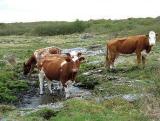 |
Grazing areas and/or periods restricted by limited water availability |  |
Improving water facilities, e.g. installing nose pumps | |
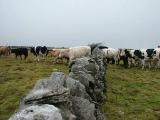 |
Lack of influence over grazer distribution (e.g. gaps in internal walls) | 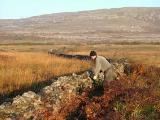 |
Restoring internal stone walls | |
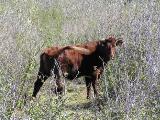 |
Scrub encroachment inhibiting livestock movement around winterages | 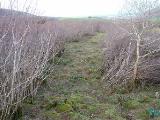 |
Creating access paths through scrub | |
 |
Scrub encroachment on priority habitats | 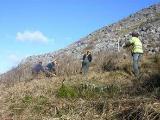 |
Clearing encroaching scrub from targeted areas | |
 |
Scrub encroachment and rough terrain hampering vehicle access for time-pressed farmers | 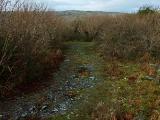 |
Creating vehicle access paths | |
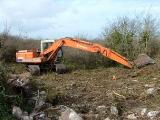 |
Lack of awareness of the importance of priority habitats and their management requirements |  |
Raising awareness through an extensive education programme e.g. farm demonstration days | |
Scrub control
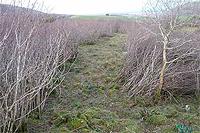
One of the actions carried out by the BurrenLIFE Project is scrub control. Encroaching hazel and blackthorn has been cut and paths opened up to improve cattle movement, and consequently, grazing levels, and to facilitate cattle herding. This task has been carried out by local contractors from a database of workers developed by the project. The removal of encroaching scrub has had a significant impact on the Burren habitats. There appears to be an increase in the number of orchids and other flowering plants in monitoring areas. Scrub removal work has also had a positive impact in terms of supporting the income of the local farming and non-farming community.
Livestock management, access and water provision
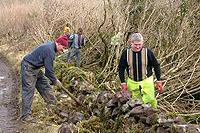
Many areas of the Burren are accessible only on foot. This can make herding and livestock management particularly difficult especially for part-time farmers, the number of which is increasing. One of the main problems addressed by the BLP is improving access onto winter grazing areas. In the past, many farmers resorted to bulldozing tracks which caused considerable damage to the priority habitats. The project solution has been to pilot a system of best practice routes on six LIFE farms using ‘minimal impact’ construction. The most suitable route is identified in terms of minimising damage to the priority habitats present and local limestone chip is then used to level the ground by overlaying and infilling. The tracks have had a dual benefit: improved access for the farmers and better grazing levels as the cows use them to move round too.
The karst nature of the Burren means that water is often in short supply, as most of the water is underground and the supply unpredictable. Water provision is a major issue for farmers and the project has funded a range of solutions from the use of ‘hydram pumps’, pasture pumps, piping and tanks, to cleaning out old walled-springs and walling off new ones.
Another important project action is the rebuilding of internal stone walls to make them stock-proof. One of the characteristics features of the Burren, the walls are vitally important to help manage stock and land as they facilitate herding while also ensuring that grazing can be targeted.
Grazing and feeding
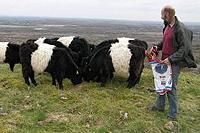
Getting the grazing and feeding systems right is another significant aspect of conservation and agricultural production on Burren farms. The BurrenLIFE project and Teagasc (the national agriculture and food development authority; one of the project partners) are working closely with farmers to implement new feeding systems through the development of individual farm management plans. Changes have included extended winter grazing in traditional winterage areas, adjustment of winter grazing levels, the reintroduction of light summer grazing of winterages and targeted grazing. A user-friendly system of ‘Grazing Days’ has been developed, allowing the farmer greater flexibility in the management of the land. In a bid to encourage farmers to cut down on the use of silage, a special supplementary concentrate feed has been formulated which is tailored to suit the Burren and the animals’ mineral and nutritional requirements. Farmers have reported high satisfaction with this feed and a major improvement in the level of grazing by animals, which will enhance biodiversity. Another benefit of switching from silage to concentrate feed is the potential improvement in animal health. Farmers using the concentrate feed have noted the general good health and calving success of out wintered cattle.
Heritage Education Programme
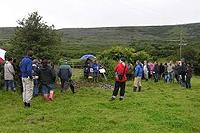
Since 2005 the BurrenLIFE project has been running a multidimensional educational programme of events targeted at various sectors of the Burren community, particularly local school children and the local farming community. One of the most important elements of the Heritage Education Programme has been a number of public lectures and field trips featuring the farmers as the main speakers.
In January 2009, the BLP launched Ireland’s first farming for conservation DVD entitled- Farming the Living Landscape of the Burren. The DVD tells the story of farming for conservation in the Burren and the work of the BLP with input from participating farmers, the BLP and project partners.
Blueprint for HNV farming in the Burren
A sustained programme of monitoring and research means that the BLP is on target to deliver a tested, practical model for the sustainable agriculture management of the priority habitats in the Burren.
Habitat assemblages and their management requirements are highly variable within and between countries, yet agri-environment schemes are generally implemented at a national level without being targeted at distinct geographic regions of high nature value (European Environment Agency 2004). The management recommendations that have emerged from the BLP have gained overwhelming support from the local farming community. Some of these measures have recently been incorporated into revision of the existing agri-environment scheme (REPS) while others will require new mechanisms of support. Such intervention is critical for the long-term conservation of the rich heritage of the Burren’s flagship landscape. The BurrenLIFE shows that targeted actions, developed and implemented in partnership with local farmers is a model for future conservation efforts in high nature value areas.
Further information on the BurrenLIFE Project can be viewed on www.burrenlife.com


